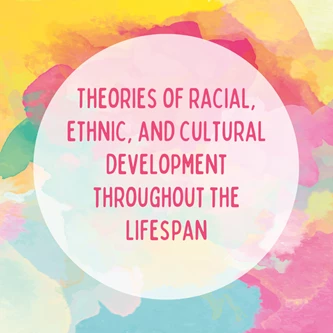 Here's a item straight from the ASWB content outline: Theories of racial, ethnic, and cultural development throughout the lifespan. You may know them well; they may be entirely new to you. Either way, time for some quick review (with some links for a deeper dive) to help you get ready for social work licensing exam questions addressing this topic.
Here's a item straight from the ASWB content outline: Theories of racial, ethnic, and cultural development throughout the lifespan. You may know them well; they may be entirely new to you. Either way, time for some quick review (with some links for a deeper dive) to help you get ready for social work licensing exam questions addressing this topic.
These theories and perspectives offer frameworks for exploring the complex and dynamic nature of racial, ethnic, and cultural development across the lifespan, recognizing that identity is a multifaceted and evolving aspect of an individual's life journey. Which ones does the ASWB have in mind? Probably one of these:
Phinney's Model of Ethnic Identity Development:
Developed by Jean Phinney, this model outlines stages of ethnic identity development, including Unexamined Ethnic Identity, Ethnic Identity Search, and Achieved Ethnic Identity, as people explore and develop their cultural identity. Details.
Intersectionality Theory:
Kimberlé Crenshaw's intersectionality theory recognizes that people have multiple social identities (e.g., race, gender, sexuality) that intersect and interact to shape their experiences and opportunities. It is particularly relevant for understanding the unique experiences of people with multiple marginalized identities. Details.
Bronfenbrenner's Ecological Systems Theory:
Urie Bronfenbrenner's theory underscores the influence of various systems, including the microsystem (family and immediate environment) and macrosystem (societal culture and values), on an individual's cultural and racial identity development. Details.
Helms's White Racial Identity Development Model:
Janet Helms proposed a model specific to white people, outlining stages of awareness and understanding of their own–and others’--racial identity. The stages include Contact, Disintegration, Reintegration, Pseudo-Independence, Immersion-Emersion, and Autonomy. Details.
Social Identity Theory:
Developed by Henri Tajfel and John Turner, this theory focuses on how people categorize themselves and others into social groups, including racial and ethnic groups. It explores how group membership influences self-concept and behavior. Details.
Identity Formation Theories:
These encompass various psychological theories, including identity diffusion, identity foreclosure, identity moratorium, and identity achievement, which can be applied to understand how people develop their cultural and racial identities throughout the lifespan. Among these: Erik Erikson's stages of psychosocial development (most relevantly, the Identity versus Role Confusion stage), James Marcia's identity status theory, and Jeffrey Arnett's theories of identity formation in emerging adulthood. Details.
Here’s a (sort of clunky) practice question drawn from the above theories--Phinney, to be precise:
A social worker is counseling a young adult client who is struggling with issues related to their cultural identity. The client is engaged in exploration and self-reflection about their cultural background. According to Jean Phinney's model of ethnic identity development, which stage is the client most likely in?
A) Pre-encounter
B) Immersion-Emersion
C) Achieved Ethnic Identity
D) Identity Foreclosure
Do you know the answer?
Jean Phinney's model of ethnic identity development outlines three main stages: Unexamined Ethnic Identity, Ethnic Identity Search, and Achieved Ethnic Identity. The client in this scenario is most likely in the Immersion-Emersion stage, the phase of active exploration and questioning.
You’re now that much more ready to go pass the ASWB exam.
Want to really get ready? Get started with SWTP’s full-length practice tests.

 Here's a item straight from the ASWB content outline: Theories of racial, ethnic, and cultural development throughout the lifespan. You may know them well; they may be entirely new to you. Either way, time for some quick review (with some links for a deeper dive) to help you get ready for social work licensing exam questions addressing this topic.
Here's a item straight from the ASWB content outline: Theories of racial, ethnic, and cultural development throughout the lifespan. You may know them well; they may be entirely new to you. Either way, time for some quick review (with some links for a deeper dive) to help you get ready for social work licensing exam questions addressing this topic.